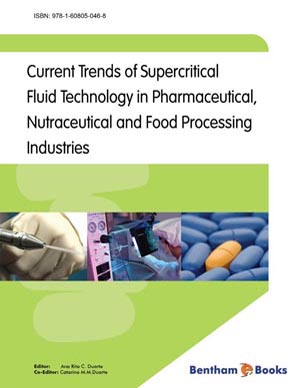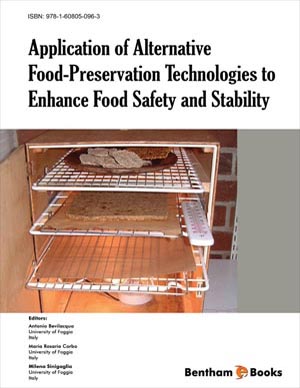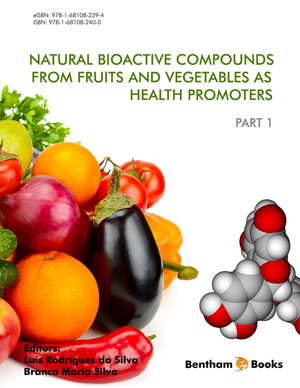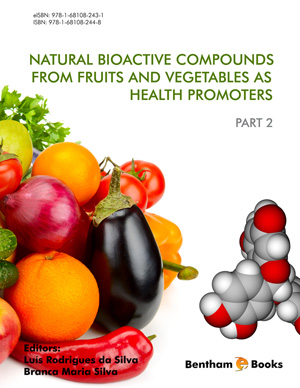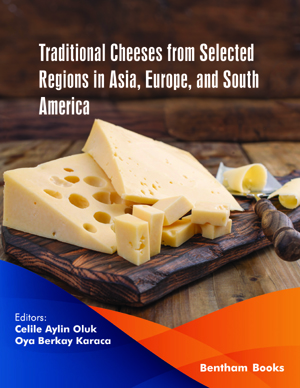Preface
Page: ii-ii (1)
Author: Ana Rita C. Duarte and Catarina M. M. Duarte.
DOI: 10.2174/9781608050468110010100ii
Contributors
Page: iii-iii (1)
Author: Ana Rita C. Duarte and Catarina M. M. Duarte
DOI: 10.2174/978160805046811001010iii
Introduction to Supercritical Fluids: Basic Principles and Applications
Page: 1-7 (7)
Author: M. Nunes da Ponte
DOI: 10.2174/978160805046811001010001
PDF Price: $15
Abstract
This paper provides a short overview of developments in the field of supercritical fluids in the last thirty yearsand of actual and prospective applications
Applications of Supercritical Expansion Processes for Particle Formation
Page: 8-15 (8)
Author: Ana Rita C. Duarte
DOI: 10.2174/978160805046811001010008
PDF Price: $15
Abstract
Pharmaceutical sciences are experiencing a revolution as regards the existing technologies and the development of entirely new ones. Engineering drug itself has emerged as a new strategy for drug delivery and supercritical fluid technology offers exciting opportunities in this field. The application of supercritical fluids to the processing of pharmaceuticals has already proven its feasibility and also its applicability in the area of polymer processing as well as in the preparation of controlled release systems. It is of particular interest the key role that materials have in the development of these new drug delivery systems, from polymers, to ceramics or even metals. When a pharmaceutical agent is encapsulated within, or attached to, a polymer or lipid, drug safety and efficacy can be greatly improved and new therapies are possible. This has been the driving force for active study of the design of these materials, intelligent delivery systems and approaches for delivery through different administration routes. A review of the state of the art indicates that, in the past two decades, a lot of effort has been put in the development of new particle formation processes. The precipitation of solids with supercritical fluids has attracted many researchers as it enables the production of very small size particles with a narrow size distribution using mild and inert conditions. In this chapter a review of the supercritical expansion processed applied to pharmaceutical purposes is presented.
Supercritical Anti-Solvent Micronization: Control of Morphology and Particle Size
Page: 16-28 (13)
Author: Ernesto Reverchon and Iolanda De Marco
DOI: 10.2174/978160805046811001010016
PDF Price: $15
Abstract
Supercritical antisolvent precipitation has been used to micronize several kinds of materials. Nanoparticles with mean diameters in the 30-200 nm range and microparticles in the 0.2-20 µm range are the most frequently obtained morphologies. Sometimes, hollow expanded microparticles with diameters between about 10 and 200 µm and crystals having various morphologies have been obtained. In this work, the relation between vapor liquid equilibria and the observed morphologies has been performed; possible formation mechanisms have been proposed. If the material is precipitated from a supercritical gaseous phase, expanded microparticles can be obtained; whereas, if the process is carried out at supercritical conditions, there is a competition between jet break-up and liquid surface tension vanishing characteristic times. If surface tension disappears before the jet break-up, nanoparticles are formed from a gas plume; otherwise, micrometric droplets generate spherical micrometric particles.
Particles from Gas-Saturated Solutions and Related Methods for Particle Engineering
Page: 29-40 (12)
Author: A. R. Sampaio de Sousa and Catarina M. M. Duarte
DOI: 10.2174/978160805046811001010029
PDF Price: $15
Abstract
One of the most promising methods for particle engineering using supercritical fluids is the PGSS – Particles from gas saturated solutions and derived methods. It has been used to micronized drugs and active compounds and to produce composite particles, mainly for pharmaceutical applications, however food applications are starting to arise among experimental work with potential for industrial applications. The morphology and size of the particles obtained is diverse depending on the system used, but they are usually in a micro-nano size range. This chapter presents an overview of the basic principles of the method, several developments that were further undertaken, and a compilation of different examples and systems.
Fundamentals and Modeling of Supercritical Precipitation Processes
Page: 41-51 (11)
Author: Angel Martin and Maria Jose Cocero
DOI: 10.2174/978160805046811001010041
PDF Price: $15
Abstract
Precipitation processes based on the use of supercritical fluids have undergone considerable development during the last years. One of the main pending tasks at this moment is the development of a systematic procedure for the design and scale-up of these processes. This requires not only empirical knowledge, but also information about the fundamentals of the process. This work aims to review the published literature dealing with a fundamental investigation and modeling of supercritical fluid precipitation processes.
Supercritical Fluid Impregnation for the Preparation of Controlled Delivery Systems
Page: 52-60 (9)
Author: Ana Rita C. Duarte and Catarina M. M. Duarte
DOI: 10.2174/978160805046811001010052
PDF Price: $15
Abstract
Controlled drug delivery products, using biocompatible or biodegradable polymers, have received considerable attention in the last years. These substances provide in general a more controlled release rate of assumption of the drug by the body improving its therapeutic action. In fact, there is a growing interest of the pharmaceutical industry in the development of these systems. Impregnation using supercritical fluid technology has already proven its feasibility, in the preparation of controlled release systems. In this technique the drug component is dissolved in a compressed gas (carbon dioxide) that is used as a mobile phase and that, also, swells and stretches the polymer matrix, facilitating the diffusion of the drug, and increasing the rate of impregnation. A high purity product, free of residual solvents is obtained, since no organic solvents are involved in the impregnation process. In this chapter, the development of different successful controlled release systems is presented.
Ionic Liquids and Carbon Dioxide as Combined Solvents for Reactions and Separations: The Miscibility Switch
Page: 61-70 (10)
Author: E. Kuhne, G. J. Witkamp and C. J. Peters
DOI: 10.2174/978160805046811001010061
PDF Price: $15
Abstract
Ionic liquids (ILs) and carbon dioxide (CO2) are emerging as candidates to replace volatile organic solvents in synthesis and extraction processes. ILs are a relatively new class of substances composed only of ions and liquid at temperatures below 100oC. As a major attractive characteristic, they have negligible vapor pressure - reducing solvent loss by evaporation and environmental pollution. When used simultaneously with carbon dioxide for reactions and extractions, the process will be based on non-toxic, non-flammable solvents and will be applicable for a wide variety of compounds. It has been recently shown that carbon dioxide can be used to split phases in homogenous one-phase systems with ILs. This miscibility switch allows reactions to be carried out in one phase, and by simply changing CO2 pressure, extractions can be carried out more efficiently under heterogeneous conditions. This chapter presents an overview on ionic liquids and carbon dioxide, together with an explanation on the phenomenon of miscibility switch.
Supercritical Antisolvent Fractionation of Plant Extracts
Page: 71-79 (9)
Author: O. J. Catchpole, N. E. Durling, J. B. Grey, W. Eltringham and S. J. Tallon
DOI: 10.2174/978160805046811001010071
PDF Price: $15
Abstract
A recently developed continuous process entitled supercritical antisolvent fractionation is described for the fractionation of plant extract solutions using near-critical fluids to give two or more fractions containing bioactives with widely differing polarities. One fraction is insoluble in the near critical fluid and is precipitated by antisolvent behaviour, and the other fraction is soluble in the near-critical fluid and co-solvent, and is recovered by downstream pressure reduction. With two-stage pressure reduction, two fractions may be obtained. The extract solutions are obtained by the prior extraction of plant material using ethanol/water mixtures. The process has been tested on a wide variety of plant extract solutions, including those obtained from sage, olive leaf, hop marc, grape marc, black currant, propolis, Echinacea, St Johns Wort, and onion biomass. The key parameters controlling the process are the solvent composition, concentration of dissolved solids in the solution, flow rate ratio of solution to near-critical fluid, temperature and pressure. In general, the separation between highly polar bioactives, which are recovered in the insoluble fraction (raffinate); and low to medium polarity fractions, which are recovered in the extract fraction(s) is maximised at low soluble solids, water contents in the feed solution ≤ 30 % by mass, and flow rate ratios of feed to CO2 of ≤ 30 % when using CO2. The process is simple to scale up, and has been performed from a laboratory to demonstration scale for propolis tincture.
Mathematical Modelling of Supercritical Fluid Extraction
Page: 80-96 (17)
Author: H. Sovova
DOI: 10.2174/978160805046811001010080
PDF Price: $15
Abstract
The kinetics of supercritical fluid extraction of valuable substances from plants depends on both extract solubility in the solvent (or phase equilibrium between the matrix and the solvent) and mass transfer resistances, particularly the resistance inside vegetable material. Different mathematical models for supercritical fluid extraction have been published in the last decades and it can be therefore difficult to choose the most suitable model for particular extraction. In this chapter, simple criteria based on time constants of mass transfer and characteristic time of equilibrium extraction are presented, two most frequent types of models for supercritical extraction from plants are mentioned with references to the literature, and the factors influencing scale-up of the process are discussed.
Supercritical Fluid Processing in Food and Pharmaceutical Industries: Scale- Up Issues
Page: 97-115 (19)
Author: Fabrice Leboeuf and Frantz Deschamps
DOI: 10.2174/978160805046811001010097
PDF Price: $15
Abstract
From the early 70s, supercritical fluid processing found numerous applications at industrial scale in the food industry through extraction and fractionation processes. In the same time, over the past two decades, a wide variety of supercritical fluid (SCF)-based processes dedicated to the design and engineering of particles were investigated mainly for applications in the pharmaceutical industry. Among these particle engineering processes, none of them reached commercial and full scale production yet in the pharmaceutical industry, but a few ones finally found valuable large scale applications in the food industry. Keys for the scale-up of well-known extraction and fractionation processes, together with examples of applications are discussed briefly. After a short reminder of the various SCF-based particle engineering processes described in the literature, the scale-up issues of these particle engineering processes for industrial applications are detailed. The discussed features then focus on pharmaceutical industry peculiar requirements, such as compliance with current Good Manufacturing Practices (cGMP). Finally, examples of recent applications, together with cost estimations, are given.
Index
Page: 116-117 (2)
Author: Ana Rita C. Duarte and Catarina M. M. Duarte
DOI: 10.2174/978160805046811001010116
Introduction
Supercritical fluid technology can be seen as a green and environmentally friendly alternative to conventional. Current information on these topics is spread through different publications in different peer-reviewed journals. The editors were therefore of the opinion that this information should be gathered in an Ebook which presents some reviews on these topics which should be of major interest not only for the academia but also for the industry.


